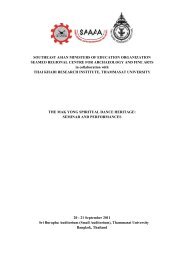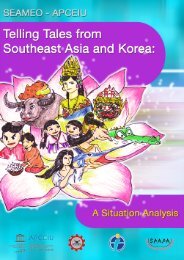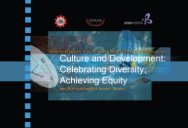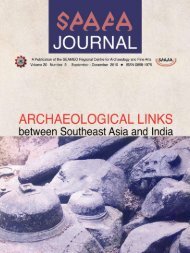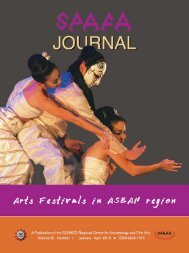Perspectives on Heritage Tourism - Seameo-SPAFA
Perspectives on Heritage Tourism - Seameo-SPAFA
Perspectives on Heritage Tourism - Seameo-SPAFA
You also want an ePaper? Increase the reach of your titles
YUMPU automatically turns print PDFs into web optimized ePapers that Google loves.
<str<strong>on</strong>g>Perspectives</str<strong>on</strong>g> <strong>on</strong> <strong>Heritage</strong> <strong>Tourism</strong><br />
<str<strong>on</strong>g>Perspectives</str<strong>on</strong>g> <strong>on</strong> <strong>Heritage</strong> <strong>Tourism</strong><br />
While many cultural organisati<strong>on</strong>s, both nati<strong>on</strong>al and internati<strong>on</strong>al,<br />
recognise the cultural value of Nhã nhạc, reviving and preserving<br />
it remains a challenge in view of the lack of funding and limited<br />
documentati<strong>on</strong>. Only a few former artists versed in the Nhã nhạc<br />
traditi<strong>on</strong> are still alive, and they are now very old. The fewer skillful<br />
Nhã nhạc practiti<strong>on</strong>ers left, the more difficult revitalisati<strong>on</strong><br />
would be. Even if students wanted to learn Nhã nhạc and make a<br />
career out of it, they would have to learn directly from teachers<br />
the melody and rhythm as well as the distinct musical notes,<br />
which cannot be learnt through usual musical notati<strong>on</strong>. The<br />
“traditi<strong>on</strong>al” or “classical” transmissi<strong>on</strong> technique presents an<br />
obstacle for the youths who are <strong>on</strong>ly familiar with the prevailing<br />
western solfège system.<br />
Lantern dance of court music is well preserved<br />
(documentary photo of Hue M<strong>on</strong>uments C<strong>on</strong>servati<strong>on</strong> Center, 2008)<br />
The preservati<strong>on</strong> of Nhã nhạc involves not <strong>on</strong>ly educati<strong>on</strong> and<br />
transmissi<strong>on</strong> but also the collecti<strong>on</strong> and research <strong>on</strong> remaining<br />
Nhã nhạc materials. There is, however, the dearth of a network of<br />
practiti<strong>on</strong>ers as well as qualified staffs who can research Nhã nhạc<br />
preservati<strong>on</strong>, collect historical documents, and archive existing<br />
materials.<br />
The overview of Khai Dinh king’s tomb and its surroundings<br />
(documentary photo of Hue M<strong>on</strong>uments C<strong>on</strong>servati<strong>on</strong> Center, 1999)<br />
A project to revitalise court music was supported by the<br />
Japanese Fund-in-Trust through the UNESCO office in Hanoi, and<br />
was implemented by the Hue M<strong>on</strong>uments C<strong>on</strong>servati<strong>on</strong> Center,<br />
starting in 2005. In this project, performance skills were imparted<br />
by master practiti<strong>on</strong>ers. Knowledge of the young generati<strong>on</strong>,<br />
including students and teachers, are also enriched through various<br />
ways of disseminating Nhã nhạc.<br />
62<br />
63



